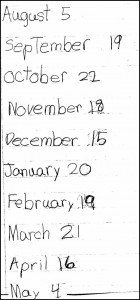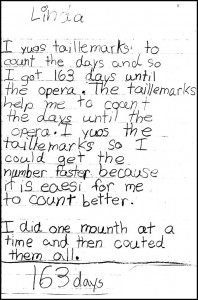In order to become true mathematicians and critical thinkers, we must first understand that not every problem has only one correct answer and there are multiple ways to arrive at a solution. In the process of creating an original opera, students encounter daily opportunities to apply their math thinking in authentic contexts.
The first day of school we posed an open-ended question to initiate the process of solving multi-step problems and to introduce the concept of the opera. We presented a problem that would naturally and logically incorporate the skills and strategies of our first quarter math curriculum.
How much time do we have to prepare for our opera?
Having this information is imperative in order to plan for the opera. Our purpose was clear. We needed this information FOR REAL.
With this question, students immediately began to respond and ask questions. Where do we start? What do we do? It was completely up to them. They determined fairly quickly what information they needed to set them in motion . . . the date of the opera premiere, May 7. They listed tools they might need to help them, such as a school calendar, counters of different types, a hundreds chart, etc. Working collaboratively in partners or small groups, they set to work. Every day they shared strategies and ideas as they moved closer to determining a solution. By talking with one another, they deduced what made sense and what needed further exploration and processing.
As they worked, misconceptions, arithmetic mistakes and gaps in understanding became evident to me. In the same way I could see what they knew and exactly how they were thinking as they explained their respective strategies and solutions.
Most students were eager to find a solution, but were reluctant to record their work. Training them to explain their thinking in writing and to show specific strategies on paper is certainly a process that develops over time, one that is critical to deeper understanding. We all know that kids love shouting out, “I’m done.” They will soon learn that there is always something to improve or revise.
Using student work as examples for instruction is powerful.
Every day I searched for student samples to demonstrate a particular skill, strategy or mathematical understanding. The first student to realize we could not include Saturdays and Sundays in our calculations for preparation days, shared his discovery and the rest of the group acknowledged this fact and changed course. The same then followed with holidays. Without me spoon feeding a predetermined strategy to solve the problem, students were forced to reason, to think on their own.
Take a look. What do YOU see?





